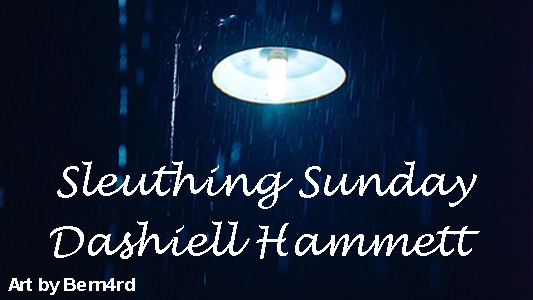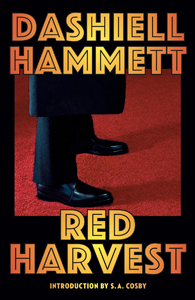Modern readers diving into Dashiell Hammett might start with “Red Harvest” (1929), as it’s the first of the former Pinkerton detective’s five novels. But in that era of magazine standalone and serialized stories, folks were already familiar with the Continental Op. Debuting in 1923, he was one of the inaugural hardboiled detectives – and still one of the best, which is why I think I’ll pick up “The Big Book of the Continental Op” (2017).
Originally titled “The Cleansing of Poisonville,” “Red Harvest” isn’t a bad place to start with Hammett and the Op. We get delicious clipped and to-the-point narration and dialog on every page from the unnamed detective, who works out of the San Francisco office.
Hammett’s language is so consistently excellent that I could turn to three random pages and find a tasty bit of rough-hewn poetry. Here, I’ll go to three pages based on my birthdate numbers:

“Red Harvest” (1929)
Author: Dashiell Hammett
Genre: Hardboiled mystery
Series: The Continental Op
Setting: Poisonville, western U.S., 1920s
- As the Op and Bill Quint have spent long enough viewing a corpse in the street: “He’s not going to die anymore,” he said. “Which way you going?” “Any.”
- As the Op and the police chief visit a witness: We were taken upstairs to where Donald Willsson’s widow sat in the library. She was in black. Her blue eyes had frost in them.
- The Op explains to his colleagues why he’s holding off on reporting back to their boss: “Anybody that brings any ethics to Poisonville is going to get them all rusty. A report is no place for the dirty details, anyway.”
The original Sin City
In “Red Harvest” (which likely inspired the fake “Return of the Jedi” title “Blue Harvest” and, coming full circle, the “Star Wars” EU horror novel “Red Harvest”), the Continental Op tackles the 40,000-resident town of Personville (perhaps in Utah, as Ogden is the nearest city).
The town’s nickname comes from the yellow sky created by smokestacks in a valley in the mountains, and also for the east-coast mispronunciation. But most of all, the name reflects its lawlessness, as Poisonville is essentially a 1920s version of what Frank Miller would do with his 1990s comic “Sin City.”
A few novels later, in “The Glass Key,” Hammett explores an unnamed eastern town where every office-holder is corrupt. I rate that as a slightly superior novel to “Red Harvest” because readers tend to be less familiar with the ins and outs of governmental corruption compared to official criminal corruption.
But in Personville, almost every single resident is engaged in illegal schemes – all the officials, all the black marketers and most of the citizens. As such, “Red Harvest” borders on being a satire (albeit a good one), filled with wild car chases, fist fights, shootouts and a pile of bodies.

Yet the characters – even our unnamed Op – are so well-drawn that Personville is strikingly real. The informant Dinah Brand is always described with ripped stockings, and she’s always drinking and smoking (although to be fair, everyone is), and she only lifts a finger if there’s money to be made – and yet she’s among the most upstanding characters!
Written on the fly – like real life
Amid this den of dishonorable thieves, Hammett pulls off another neat incongruity: “Red Harvest” feels very much like a novel made up on the go (the four parts ran in 1927-28 in magazine form), yet — if not necessarily a perk – it’s not a bug. The initial murder is solved, abruptly and shockingly, only one-third of the way through the book.
The story isn’t over, though, because this is merely the Op’s first step in cleaning up the town. That’s another way “Red Harvest” reflects real life: The solving of a first-page murder need not happen on the last page.
Granted, another unsolved murder later takes the spotlight. This one is more personal to the Op, since he’s a suspect. And he even briefly suspects himself (Philip K. Dick would’ve tipped his cap) because his memories are fuzzy with booze, and he awakens holding the handle of an ice pick that’s in the victim’s chest.
“Red Harvest” is about seeing a dirty job done well. It has nothing philosophical or analytical to say about the why and how of municipal corruption; such conditions are a given in the Prohibition era. In one against-the-grain segment, the Op worries the town is making him go “blood simple.” But generally it’s a procedural about the cleanup process.
Despite the high entertainment value, borderline satirical tone and bitten-off phraseology that probably had stylists from Frank Miller to the “Police Squad!” writers drooling as they mimicked it, “Red Harvest” remains grittily grounded in a mountain town. The novel is a slice of life (or should we say a stab of life?) in the Rip-Roaring Twenties – and one that’s still immensely readable in the Boring Twenties.
Sleuthing Sunday reviews the works of Agatha Christie, along with other new and old classics of the mystery genre.

